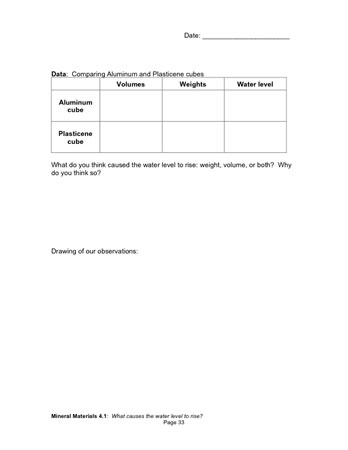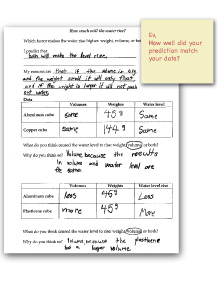What causes the water level to rise?
Plan Investigation 4.1
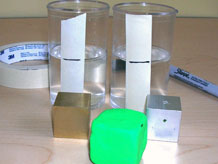
What makes the bathtub overflow when a person settles in for a bath? Is it weight or volume? It's the volume, but children often believe it is weight that "pushes the water out of the way." In this investigation, students confront this idea head on.
Today, students gather evidence to decide if weight or volume is the determining factor in the displacement of water.
Formative Assessment
Available online at inquiryproject.terc.edu
By the end of this investigation students will understand that objects submerged in water will always change the water level, and that it is volume, not weight, that determines how much water will be moved aside.
Learning Goals
- Discover what property of a sunken object makes the water rise
- Understand that two objects cannot occupy the same space at the same time
| Sequence of experiences | ||
|---|---|---|
| 1. Ask the question | All Class | 10 Mins |
| 2. Explore water displacement | Small Groups | 15 Mins |
| 3. Share data | All Class | 5 Mins |
| 4. Make meaning | Discussion | 15 Mins |
Materials and Preparation
For the class:
- Post the investigation question in a place where all students can see it.
- Prepare two class data charts, one for weight, another for volume; examples are shown in the notebooks and in Step 3.
Have the following materials ready for a demonstration at the start of class:

- 2 150cc containers with a vertical strip of masking tape applied to the outside, each approximately half full of water
- 2 rocks or minerals, one visibly larger than the other (each must fit in 150cc container)
- 1 aluminum cube (44g)
- 1 copper cube (147g)
- 1 44g cube of plastic modeling clay (same weight as aluminum cube)
- 1 3oz cup of water
- 1 pipette
- 1 plastic fork
- 1 fine tip permanent marker
- 1 paper towel
For each tray:
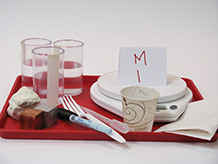
- 3 150cc containers with a vertical strip of masking tape applied to the outside, each approximately half full of water
- 1 aluminum cube
- 1 copper cube
- 1 piece of plastic modeling clay weighing approximately 50g
- 1 pipette
- 1 3oz cup of water
- 1 fork
- 1 fine tip permanent marker
- 2 paper towels
- 1 digital scale
Can students use evidence to reason that volume, not weight, determines how high the water level will rise?
Look for evidence in students’ notebook pages. As you interpret the notebook entries, remember that children typically think that heavier objects displace more water than lighter ones.
Does the student:
- Claim it’s volume and refer to evidence: (1) The aluminum and copper cubes had same volume and very different weights and water rose the same amount. (2) The two cubes with different volumes, made the water level rise different amounts.
- Claim it’s not weight and refer to evidence: (1) When the volumes were the same, the heavier cube did not make the water level rise more. (2) When the weights were the same but the volumes were different, the cube with the greater volume made the water level rise more.
As a next step, hold up a steel cube and a nylon cube and ask, “Which cube would make the water level rise more?”
1. Ask the question
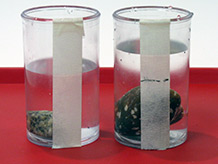
Show the students the two containers of water and the two rocks.
- What do you predict will happen when I add this larger rock to this container of water?
As students predict, ask them to explain their reasoning.
Before placing the rock in the water, show students how to draw a line to record the initial water level. Demonstrate lowering your eyes to the level of the water to accurately see its level and then draw a line on the masking tape. Next, use a fork to lower the rock into the container. Explain that you don’t want any water to splash out because that would change the amount of water in the container. When students have confirmed that the water level has risen:
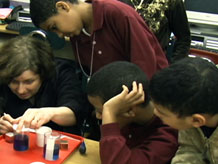
What do you think caused the water to rise?
Students may say, "The rock pushed the water away," or "The rock is heavier than the water so the rock went down and the water went up." Some may suggest "size" or "volume" is responsible, or maybe "pressure" or "gravity." Accept all suggestions without comment for now.
Show students the smaller rock.
- What will happen when I put this smaller rock into the second container? Will the water level rise the same amount? More? Less? Why do you think so?
Before lowering the smaller rock into the second container, make sure the water level matches the starting level marked on the first container. Use the pipette to add or remove enough water to get them exactly equal, then mark the container. Use the fork to lower the smaller rock into the water without splashing.
- What do you notice?
Displacement: When an object is submerged or partially submerged in water, the object displaces, or "puts out of place" the water originally in the space now occupied by the object. This happens because two objects cannot occupy the same space at the same time. Scientists call this phenomenon water displacement. Water leaves no space between itself and a submerged object, so when an object is added to a container of water, the volume of stuff below the water line increases from the volume of just the water to the volume of the water plus the submerged object.
Students should see that both rocks caused the water level to rise, and that the larger rock raised the water level more than the smaller rock. Let students know that the scientific term for this change in water level is water displacement. The water moves away because the rock has taken its place.
- Why do you think one rock displaced more water than the other?
- Is it the weight of the bigger rock or its volume? How can we find out?
Have students brainstorm among themselves, then ask them to share their thoughts with the class. Listen for a suggestion of a controlled comparison or "fair test", i.e., to test two objects with the same volume but different weights — or the same weights but different volumes — and observe the difference in the amount of water that is displaced.
2. Explore water displacement
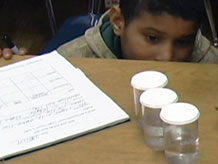
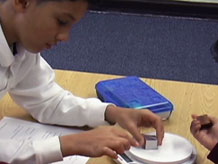
Return to the investigation question:
What causes the water level to rise?
Explicitly point out that we are trying to determine if volume or weight is the cause.
Distribute a tray of materials to each group. Ask students to examine the two cubes to see how they compare. Do they agree that they have the same volume? Can they tell that the copper cube is much heavier than the aluminum cube?
Point out the plastic modeling clay and the scale. Let students know they can cut and form the plastic modeling clay into a third cube having the same weight as the aluminum cube.
Ask students to help you list the steps for a fair test that will answer the investigation question. An example is given below.
Steps for a Fair Test:
- Equalize the starting water levels and mark them on the containers.
- Weigh the 2 cubes.
- Compare the volumes of the 2 cubes.
- Carefully place the cubes in the containers of water.
- Compare the water levels in the containers.
- Compare the water levels of the two cubes that have the same weight (i.e., the aluminum cube and the plastic modeling clay cube).
Have students open their science notebooks and record their predictions, then set the groups to work. Students should first compare the aluminum and copper cubes and then work on comparing the aluminum and plastic modeling clay cubes.
As you circulate among the groups, confirm that the volume of the plastic modeling clay cube is greater than the volume of the aluminum cube. Make sure students are recording their predictions and their data in their notebooks [How much will the water level rise?].
Let students know that the only quantitative data they will record is the weight of the cubes (in grams); the volume data and the water levels will be comparative data, e.g., " volume is greater than the other." or "the water rose higher."
3. Share data
Ask students to help you fill in the class data charts. The data will look something like this.
Comparing Aluminum and Copper Cubes
| Volume | Weight | Water level | |
|---|---|---|---|
| Aluminum cube | Same as copper | 44 grams | Same as copper |
| Copper cube | Same as aluminum | 147 grams | Same as aluminum |
Comparing Aluminum and Plastic Modeling Clay Cubes
| Volume | Weight | Water level | |
|---|---|---|---|
| Aluminum cube | Smaller than plastic modeling clay | 44 grams | Lower than plastic modeling clay cube |
| Plastic Modeling Clay cube | Larger than aluminum | 44 grams | Higher than aluminum cube |
Resolve any conflicts in the data before moving on to the discussion.
4. Make meaning
Purpose of the discussion
The purpose of the discussion is to construct an explanation together of what causes the water to rise. The resulting explanation should be consistent with observations and evidence. Begin the discussion by returning to the investigation question.
Engage students in the focus question
Weight or volume, which causes the water level to rise?
Engage students in the topic by asking them to talk a couple of minutes to talk with a partner about their claims and the evidence that supports their claims. Provide three 150cc containers with equal volumes of water and an aluminum, copper, and plastic modeling clay cube for students to refer to during their discussion, as well as the data they recorded in their notebooks.
Open the full-class discussion with the focus question.
Is it weight or volume that causes the water level to rise?
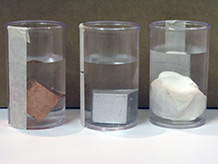
Supporting questions
- What do the data tell us? (Refer to the class data chart.)
- What claim can you make: can you claim it's the volume that causes the water to rise? Or do you claim it's weight? What is your evidence that supports your claim? And what is your reasoning?
- How do you explain the results?
Note: From their investigation, students have evidence to reason that weight is not a factor in raising the water level.
The aluminum and copper cubes weigh different amounts but the water levels rose equally.
The aluminum and plastic modeling clay cubes weigh the same but the water levels rose unequally.
Students also have evidence to reason that volume is a factor in raising the water level.
The aluminum and copper cubes have equal volumes and the water levels rose equally.
The aluminum and plastic modeling clay cubes have different volumes, and the water levels rose unequally.
The underlying reason — the explanation — why the water rises is because two objects cannot occupy the same 3-D space at the same time. Volume, and not weight, is the property of an object that describes the amount of 3-D space an object takes up.
Students may not be able to clearly articulate this explanation; they may say the rock “pushed the water out of the way”. In response, you may ask, “Why? Why couldn't the water just stay in the same place after the rock was dropped in?”
Support the discussion with "moves" such as:
- Who wants to repeat (student A)'s explanation using different words?
- Do you agree or disagree? Does that reasoning make sense to you?
When you think the group is convinced that it is volume that determines how much water is displaced, ask students for an explanation of the displacement phenomenon.
- Does it make sense that it's volume and not the weight of an object that determines how high the water will rise? How do you explain this?
- What happens to the water when an object sinks in it? Where does it go?
- Water will go in whatever direction the shape of the container allows. In a straight-sided container it will move straight up. In a bowl with sloping sides, it will move up and sideways. If the container is full, the water will overflow.
- Have you seen water displacement happen anyplace else?
- In the bath tub, in a cooking pot, in a puddle when you step in it.
Summarize the discussion and recap the investigation
Here is what I think I heard you say:
Use the same language that students have used to summarize the discussion. Include student comments that address claims and evidence, but be sure to highlight students' reasoning and explanations of displacement.
Describe the initial observations using rocks, and the dilemma of not being able to determine whether it was weight or volume that was causing the water level to rise. The rock with the greater volume also weighed more.
The tests students did using the three cubes allowed us to separate weight from volume; in both tests, it became clear that volume was the property that determined how much the water rose, and weight did not make a difference.
A key concept is that two objects cannot occupy the same 3-D space at the same time.




